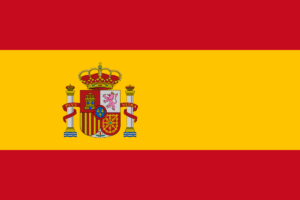| Capital | Madrid |
| Population | 47,511,640 (Source: 2023 worldometer) |
| Major Cities | Madrid (capital), Barcelona, Valencia, Seville, Zaragoza, Malaga, Murcia, Palma, Las Palmas and Bilbao |
| Borders | Morocco, Andorra, France, Portugal, and Gibraltar |
| Gross Domestic Product (GDP) | $1,397,510,000,000 (2022 worldometer) |
| Currency | euro (EUR) |

Spain Major Industries: textiles and apparel (including footwear), food and beverages, metals and metal manufactures, chemicals, shipbuilding, automobiles, machine tools, tourism, clay and refractory products, footwear, pharmaceuticals, medical equipment
Spain Agricultural Products: grain, vegetables, olives, wine grapes, sugar beets, citrus; beef, pork, poultry, dairy products; fish
Spain Natural Resources: coal, lignite, iron ore, copper, lead, zinc, uranium, tungsten, mercury, pyrites, magnesite, fluorspar, gypsum, sepiolite, kaolin, potash, hydropower, arable land
Spain Major Exports: machinery, motor vehicles; foodstuffs, pharmaceuticals, medicines, other consumer goods
Spain Major Imports: machinery and equipment, fuels, chemicals, semifinished goods, foodstuffs, consumer goods, measuring and medical control instruments
Total Size of Spain: 505,990 km² (source: 2022 nationsonline)
Geographical Low Point of Spain: Atlantic Ocean 0 m
Geographical High Point of Spain: Pico de Teide (Tenerife) on Canary Islands 3,718 m
Climate of Spain: Temperate; clear, hot summers in interior, more moderate and cloudy along coast; cloudy, cold winters in interior, partly cloudy and cool along coast
General Terrain of Spain: large, flat to dissected plateau surrounded by rugged hills; Pyrenees in north
World Region or Continent of Spain: Europe
Geographical Coordinates: 40 00 N, 4 00 W
Major Landforms of Spain: Spain is part of the Iberian Peninsula. Major landforms include the Andalusian Plain, Cantabrian Mountains, the Pyrenees, Maseta Central Plateau, Sistema Central Mountains, the Sierra de Guadalupe Mountains, and the Canary Islands.
Major Bodies of Water: Tagus River, Ebro River, Duero River, Guadalquivir River, Lake Sanabria, Lake Banyoles, Bay of Biscay, Atlantic Ocean, Mediterranean Sea
Famous Places of Spain:
Alhambra fortress in Granada,
El Escorial,
Sagrada Familia,
Aqueduct of Segovia,
Pamplona,
Palacio Real,
Costa del sol,
Ibiza,
Barcelona,
Mosque of Cordoba,
Plaza Mayor in Madrid,
Montserrat
Spain Government Type: parliamentary monarchy
Spain Nationality: Spaniard(s)
Spain National Holiday: National Day, 12 October
Other Holidays of Spain: New Years’ Day (January 1), Epiphany (January 6), Maundy Thursday, Good Friday, Labor Day (May 1), Assumption (August 15), National Festival of Spain (October 12), All Saints Day (November 1), Constitution Day (December 6), Immaculate Conception (December 8), Christmas (December 25)
Spain Independence: The Iberian peninsula was known by a number of independent kingdoms prior to the Muslim occupation that began in the early 8th century AD and lasted nearly seven centuries; the small Christian redoubts of the north began the reconquest almost immediately, culminating in the seizure of Granada in 1492; this event completed the unification of several kingdoms and is traditionally considered the forging of present-day Spain.
Spain National Symbol:
- Animal – Bull
- Bird – Spanish Imperial Eagle
- Flower – Red carnation
- Motto – Further Beyond
- Dance – Flamenco
- Colors – Yellow and red
- Other symbols – Catalan donkey, Spanish coat of arms
Spain National Anthem or Song: Himno Nacional Espanol (National Anthem of Spain)
Spain Languages Spoken: Castilian Spanish 74%, Catalan 17%, Galician 7%, Basque 2%; note – Castilian is the official language nationwide; the other languages are official regionally
Spain Religions: Roman Catholic 94%, other 6%
| Names | Professions |
| Francisco Pizarro | Explorer |
| Pablo Picasso | Painter |
| Rafael Nadal | Tennis player |
| Andres Iniesta | Soccer player |
| Julio Iglesias | Singer |
| Rita Hayworth | Actress |
| Pau Gasol | Basketball player |
| Francisco Franco | Dictator |
| Ferdinand II | King of Aragon |
| Hernando de Soto | Explorer |
| Juan Ponce de Leon | Explorer |
| Salvador Dali | Artist |
| Penelope Cruz | Actress |
| Hernan Cortes | Explorer and conquistador |
| Miguel de Cervantes | Author who wrote Don Quixote |
The world’s largest food fight festival takes place in Spain. Once a year in a town near Valencia he gathers more than 20,000 people to take part in the big tomato fight festival “La Tomatina”. Festival goers, for fun he throws 150,000 tomatoes at each other. Strange as it may sound, believe it or not, tickets sell out instantly.
Spain has four official languages. Spanish is the official language of Spain and is spoken by 72% of the population. However, six of Spain’s 17 autonomous communities have an official language other than Spanish. They are Catalan, Basque, Galician and Aranean.
Spain is the biggest defender and supporter of LGBTQ+ rights. In fact, in 2005 Spain became the third country in the world to legalize same-sex marriage. Same-sex adoption was also legalized in the same year. Spanish cities like Madrid, Barcelona, Valencia and Málaga host many pride parades and fun LGBTQ+ festivals celebrating love and equality.
His Casa Botín in Madrid, founded in 1725, is the oldest surviving restaurant in the world. It is one of the most visited tourist spots and is always fully booked. Hemingway also mentions roasting pigs in his novels.
Spanish is the second most spoken language in the world after Mandarin. Worldwide he is spoken by more than 559 million people in Spanish. Of these, 460 million are native speakers.
Known for its high quality, Spanish olive oil is used in many traditional Spanish dishes such as gazpacho, paella (Spain’s national dish) and tortilla espanola. Besides cooking, olive oil is also used in cosmetics, soaps and other products.

